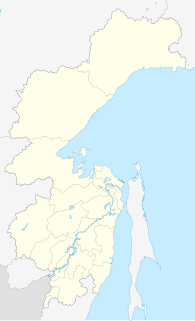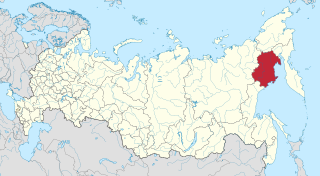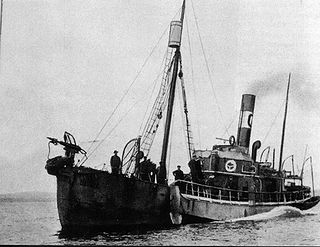
Shelikhov Gulf is a large gulf off the northwestern coast of Kamchatka, Russia. It is located in the northeastern corner of the Sea of Okhotsk and it branches into two main arms, Gizhigin Bay to the west and Penzhina Bay to the east. Its southwest corner is formed by the P'yagin Peninsula, Yam Gulf and the Yamsky Islands.

The Shantar Islands are a group of fifteen islands located off the northwestern shore of the Sea of Okhotsk east of Uda Gulf and north of Academy Bay. Most of the islands have rugged cliffs, but they are of moderate height; the highest point in the island group is 720 metres. The name of the island group has its origins in the Nivkh language from the word ч’андь/č’and’’ meaning "to be white". The islands are currently uninhabited.

Feklistova or Feklistov Island is one of the Shantar Islands in Sea of Okhotsk. With an area of 372 km², it is the second largest in the archipelago.

Zavyalov Island, formerly Ola Island, is a relatively large island in the Sea of Okhotsk, northwestern Pacific. It is located on the eastern side of Taui Bay, 20 km west of Cape Taran, Koni Peninsula, about 50 km south of the city of Magadan.

Iony Island, or Jonas' Island, formerly Ostrov Svyatogo Iony, is a small island in the Sea of Okhotsk.

The Spafaryev Islands, or Spafaryev Island, a relatively large double island, are located in the Sea of Okhotsk. It was formerly known as Korovi Island. It lies 7 km east of the Antamlan Peninsula, the southernmost peninsula enclosing the Taui Bay from its western side.

Ulban Bay is a bay in the northwestern Sea of Okhotsk, just south of the Shantar Islands. It is a southern branch of Academy Bay to the north. The Syran and Ulban rivers flow into its head.
The Shantar Sea is a small coastal sea in the northwestern Sea of Okhotsk.

Maly Shantar Island is a small, narrow island in the northwestern Sea of Okhotsk, one of the Shantar Islands.

Medvezhy Island is a long, narrow island in the northwestern Sea of Okhotsk, the westernmost of the Shantar Islands. It lies on the eastern side of Uda Gulf. It is 12.9 km long. It is separated from the mainland by Shevchenko Straight.

Nagaev Bay or Nagayev Bay, also known as Nagayeva Bay, is a bay within Taui Bay in the northern part of the Sea of Okhotsk, Magadan Oblast, Russia.
Cape Alevina is a cape on the northern side of the Sea of Okhotsk. It is on the Koni Peninsula and forms the southeastern point of Taui Bay.

Sakharnaya Golova is a small island in the northwestern Sea of Okhotsk. It is part of the Shantar Islands National Park.

Academy Bay is a large bay in the Tuguro-Chumikansky District of Khabarovsk Krai, Russian Federation.
Bussol Strait is a wide strait that separates the islands of Broutona and Chirpoy to the west from Simushir to the east. It is nearly 58 km wide, making it the largest channel in the Kuril Islands.
Shelting Bay is a wide bay on the northern coast of the Sea of Okhotsk. It lies just west of Taui Bay. It is entered between Capes Moskvitin and Dal'ny and is about 32 km wide. Its shores are primarily high and rocky, with the exception of a sandy beach at its northwest end. Sheltered anchorages from southerly winds may be obtained in the northwestern and eastern parts of the bay.

Cape Bol'shoy Dugandzha is a headland in Khabarovsk Krai, Russia.
Yakshin Bay is a small bight in the western Sea of Okhotsk. It is 29 km wide and indents the southwest side of Bolshoy Shantar Island. The bay is entered between Capes Raduzhnyy to the west and Filippa to the east. The Yakshin River flows into the head of the bay. There is ice in the bay from December to July. Tides rise 4.9 m at springs, with the flood current flowing in a counterclockwise direction round the bay and the ebb in the reverse direction. These tidal currents may reach 3.5 to 4 knots near the entrance of the bay but are less than 2 knots at its head.
Commercial open-boat whaling by American and European ships occurred in the Sea of Okhotsk from the 1830s to the early 1900s. They primarily caught right and bowhead whales. Both populations of these species declined drastically, with the latter once thought to be extinct by western historians. Peak catches were made in the 1840s and 1850s. It's estimated that as many as 15,200 bowheads and 2,400 rights were taken in the sea.

















